Search results: "helicoverpa armigera" 21 IDaids
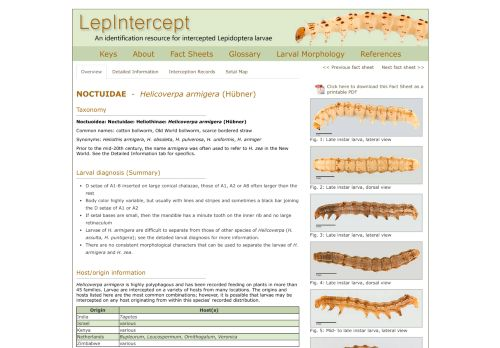
LepIntercept: An Identification Resource for Intercepted Lepidoptera Larvae: Helicoverpa armigera
Screening Aid/Fact Sheet/Pest Alert
United States Department of Agriculture (USDA)
This fact sheet for Helicoverpa armigera (cotton bolloworm or Old World bollworm) is from the fact sheet collection in LepIntercept, a USDA APHIS PPQ ITP tool . It features high-quality photos of larvae you can enlarge to see character details. Four tabs offer both an overview and detailed information, as well as “Interception Records” and a “Setal Map.” Select “Keys” from the top menu to use a Lucid key to 41 intercepted larvae, or choose from a set of dichotomous keys for advanced users.

Old World Bollworm
Screening Aid/Fact Sheet/Pest Alert
United States Department of Agriculture (USDA)
This card about OWB (Helicoverpa armigera) has images highlighting distinguishing characteristics and describes what signs on hosts to look for. Available in Spanish .
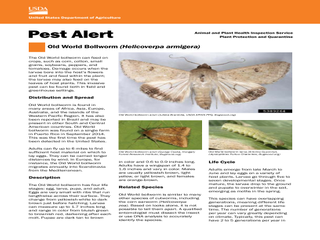
Pest Alert: Old World Bollworm (Helicoverpa armigera)
Screening Aid/Fact Sheet/Pest Alert
United States Department of Agriculture (USDA)
Hosts of the Old World bollworm include corn, cotton, small grains, soybeans, peppers, and tomatoes. This alert describes the pest, its life cycle, similar-looking species, host signs and symptoms, and includes photographs. Available in Spanish .
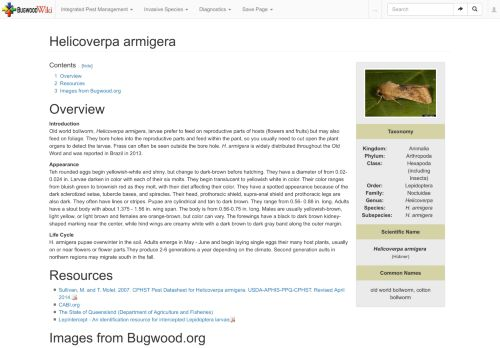
NPDN First Detector Training for Educators - Helicoverpa armigera
Screening Aid/Fact Sheet/Pest Alert, Wiki
National Plant Diagnostic Network (NPDN), United States of America
This fact sheet about the Old World bollworm covers its taxonomy, identification, biology, and hosts and includes photos. A BugwoodWiki site.
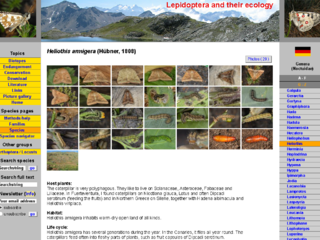
Heliothis armigera (Hübner, 1808)
Image Gallery
Wagner, W.
The current name of this moth is Helicoverpa armigera, the cotton bollworm or Old World bollworm. This website contains very general information about host plants and life cycle. There are many images of the insect as a larva and adult.

Genetic variability of the bollworm, Helicoverpa armigera, occurring on different host plants.
Journal Article
Tamil Nadu Agricultural University, India
This research paper discusses the use of simple sequence repeats (SSR) to study genetic variability in the cotton bollworm (Old World bollworm). It includes images of caterpillars on a variety of hosts.
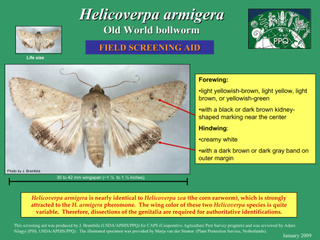
Helicoverpa armigera - Old World Bollworm - Field Screening Aid
Screening Aid/Fact Sheet/Pest Alert
United States Department of Agriculture (USDA)
This screening aid provides images of an adult moth with information about diagnostic features.

AQI Pest Guides: Cotton Bollworm
CBP Inspection Aid
United States Department of Agriculture (USDA)
This guide about the Cotton Bollworm (a.k.a. Old World bollworm) is designed for CBP Ag Specialists conducting port inspections. It covers distribution, commodities affected and their signs/symptoms of damage, and features images and port inspection notes. Click “Gallery” in top menu for a filterable image gallery.

Oregon iMapInvasive's Check List - insects
Image Gallery
iNaturalist, United States of America
The species shown here on the Oregon iMapInvasives check list are considered invasive or potentially invasive in Oregon. Many of these species have yet to appear in Oregon, and many others are being treated and managed every day. This list is hosted by iNaturalist and curated and managed by iMap project. Click on the image to see more details about the pest or change the view to show taxonomy by clicking tab at top of page.
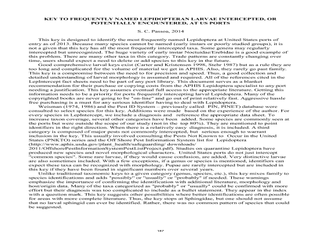
Key to frequently named Lepidopteran larvae intercepted, or potentially encountered, at U.S. ports
Chilo partellus (syn. Chilo zonellus)
Chloridea subflexa (syn. Heliothis subflexa)
Cupido comyntas (syn. Everes comyntas)
Ectomyelois ceratoniae (syn. Apomyelois ceratoniae)
Diaphania hyalinata-indica species complex.
Key
Passoa SC. 2014. Key to frequently named Lepidopteran larvae intercepted, or potentially encountered, at U.S. ports, 35 pp. In: Gilligan TM and Passoa SC. LepIntercept, An identification resource for intercepted Lepidoptera larvae. USDA-APHIS-PPQ-S&T Identification Technology Program (ITP)
This key is designed to identify the most frequently named Lepidoptera at United States ports of entry as of 2013. Because many species cannot be named (early instars or poorly studied groups), it is not a given that this key has all the most frequently intercepted taxa. Some genera may regularly intercepted but unrecognized. The huge variety of early instar Noctuidae/Erebidae is a good example of this problem. There are many other taxa in this category. Trade patterns are constantly changing over time, users should expect a need to delete or add species to this key in the future. Developed with USDA-APHIS-PPQ, available from LepIntercept, a USDA APHIS PPQ ITP tool.Chilo partellus (syn. Chilo zonellus)
Chloridea subflexa (syn. Heliothis subflexa)
Cupido comyntas (syn. Everes comyntas)
Ectomyelois ceratoniae (syn. Apomyelois ceratoniae)
Diaphania hyalinata-indica species complex.
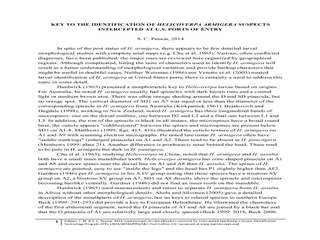
Key to the identification of Helicoverpa armigera suspects intercepted at U.S. ports of entry
Key
Passoa SC. 2014. Key to the identification of Helicoverpa armiigera suspects intercepted at U.S. ports of entry. 5 pp.In: Gilligan TM and Passoa SC. LepIntercept, An identification resource for intercepted Lepidoptera larvae. USDA-APHIS-PPQ-S&T Identification Technology Program (ITP)
Key to the intercepted species of Helicoverpa. Another version of this key with a simplified introduction is available in the LepIntercept identification tool, a USDA-APHIS-PPQ ITP tool.

Identification guide to larval Heliothinae (Lepidoptera: Noctuidae) of quarantine significance
Key, Taxonomic Description
Passia S. 2014. Identification guide to larval Heliothinae (Lepidoptera: Noctuidae) of quarantine significance. 20 pp. In: Gilligan TM and Passoa SC. LepIntercept, An identification resource for intercepted Lepidoptera larvae. USDA-APHIS-PPQ-S&T Identification Technology Program (ITP).
A preliminary key to Heliothinae larvae of quarantine significance is presented emphasizing morphology, hosts, and origins. The key includes commonly intercepted species and potential pests likely to be intercepted because of their broad host range or distribution. When the present state of our knowledge does not allow species level recognition, the key uses host and origin to give the best possible identification. This information is valuable for pest risk assessments and identification authority. Developed with the LepIntercept identification tool, a USDA APHIS PPQ ITP tool.
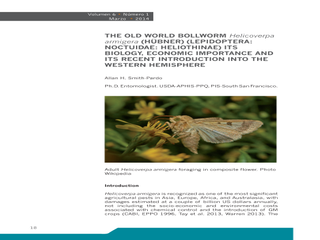
Boletí del Museo Entomológico Francisco Luís Gallego - March 2014
Journal Article
Museo Entomológico Francisco Luís Gallego, Columbia
This bulletin is in Spanish and English. It includes an article in English by Allan H. Smith-Pardo on the Old World bollworm (Helicoverpa armigera) with identification information and photographs comparing anatomical features to those of Helicoverpa zea. There is also a report in Spanish describing new species of Passillidae beetle, Verres schoolmeestersi, by Luis Carlos Pardo-Locarno with a key to the genus, and a report on beetles in the family Melolonthidae by Maria Eugenia Tabares Duque, Diana Carolina Nivia and Francisco Cristobal Yepes.
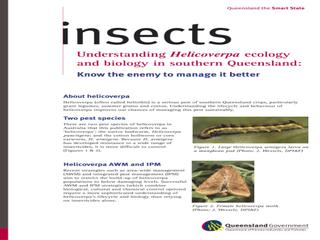
Insects - Understanding Helicoverpa Ecology and Biology in Southern Queensland: Know the Enemy to Manage it Better
Screening Aid/Fact Sheet/Pest Alert
Queensland Department of Primary Industries and Fisheries, Australia
This document discusses Helicoverpa punctigera (Australian bollworm, native budworm) and Helicoverpa armigera (Old World bollworm, cotton bollworm). It includes descriptions, images, and management information.
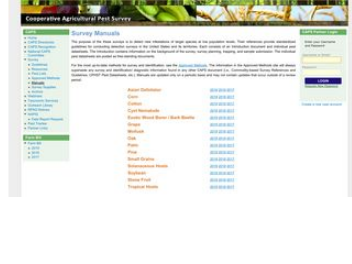
CAPS Soybean Commodity-based Survey Reference - 2018
Fact Sheet Collection
United States Department of Agriculture (USDA)
This web page provides fact sheets for pests of soybeans with identification information, images, United States risk maps, CAPS approved diagnostic method information and information about other diagnostic methods.
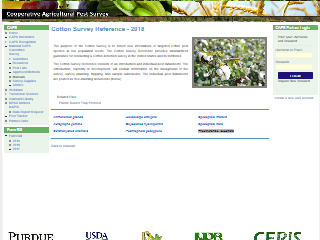
CAPS Cotton Commodity-based Pest Survey Reference - 2018
Fact Sheet Collection
United States Department of Agriculture (USDA)
This webpage provides fact sheets for a number of cotton pests with identification information, images, United States risk maps, CAPS approved diagnostic method, and other information.
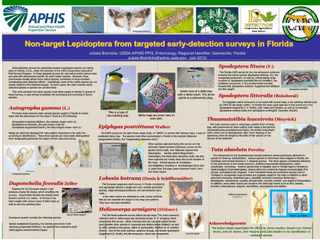
Non-target Lepidoptera From Targeted Early-Detection Surveys in Florida
Screening Aid/Fact Sheet/Pest Alert
United States Department of Agriculture, USDA
This poster contains information about non-target species of moths similar in appearance to target species of concern in Florida. There are a number of images, including dissection images.
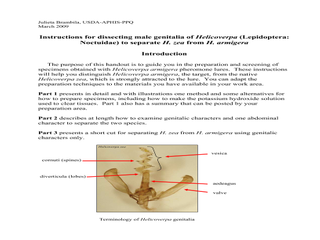
Instructions for Dissecting Male Genitalia of Helicoverpa (Lepidoptera: Noctuidae) to Separate H. zea from H. armigera
Screening Aid/Fact Sheet/Pest Alert
United States Department of Agriculture, USDA
This document provides detailed instructions with illustrations for dissection of genitalia to distinguish target species Helicoverpa armigera (Old World bollworm) from native species Helicoverpa zea (corm earworm).
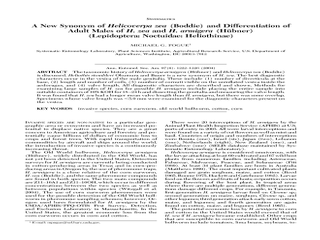
A New Synonym of Helicoverpa zea (Boddie) and Differentiation of Adult Males of H. zea and H. armigera (Hübner)
Journal Article
United States Department of Agriculture (USDA)
This research paper provides information about examining large samples of Helicoverpa zea (corn earworms) for possible Helicoverpa armigera (Old World bollworms) and for identification by dissection of the genitalia and by valve length measurements.
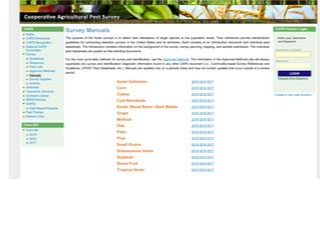
CAPS Corn Commodity-based Survey Reference - 2019
Fact Sheet Collection
United States Department of Agriculture (USDA)
This webpage covers CAPS approved survey methods and provides links to fact sheets for a number of corn pests with identification information, images, United States risk maps, CAPS approved diagnostic method information and information about other diagnostic methods.

Interactive Agricultural Ecological Atlas of Russia and Neighboring Countries
Fact Sheet Collection, Host-Based Search or Focus
Saint Petersburg University, Russia
Created in association with the USDA and Russian plant protection organizations, this site is also available in Russian. It includes crops and wild relatives, weeds, and pests (all indexed by taxonomy) and diseases (indexed by commodity), with descriptions, images, and distribution maps. Images of pests of concern include: pear leaf blister moth (Leucoptera malifoliella), summer fruit tortrix moth (Adoxophyes orana), Old World bollworm (Helicoverpa armigera), bacterial wilt (Ralstonia solanacearum).
